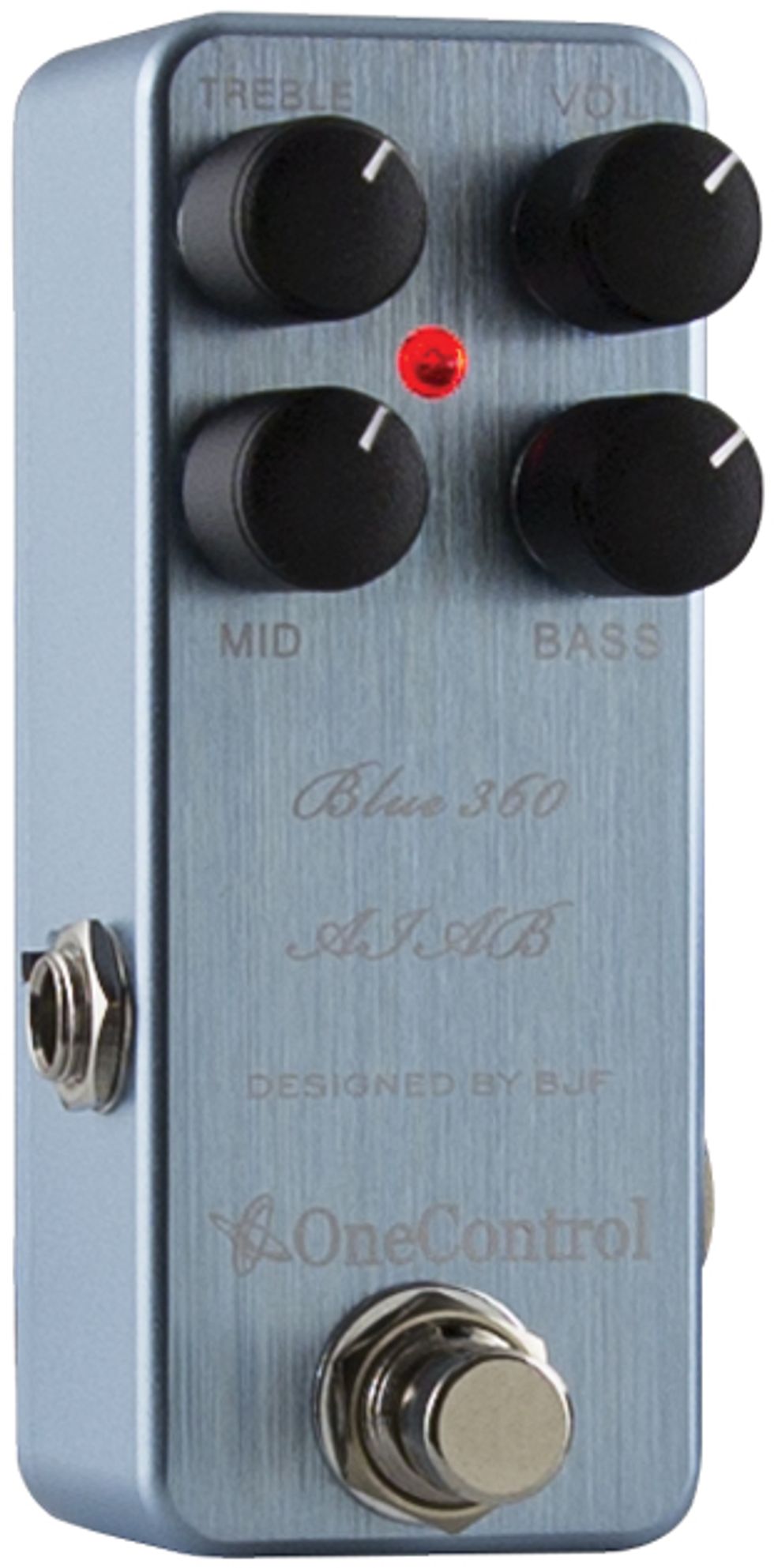
Recorded direct with Fender Precision Deluxe using PreSonus FireStudio and PreSonus Studio One 3
Clip 1: Bass at 1 o’clock, mid at 3 o’clock, treble at 3 o’clock, and volume at noon.
Clip 2: -18 dB mode engaged. Bass at 1 o’clock, mid at 3 o’clock, treble at 3 o’clock and volume dimed.
RatingsPros:Tiny footprint, dynamite tones, flexibility. Cons: The screws stripped when I attempted to access the back panel. Street: $149 One Control Blue 360 one-control.com | Tones: Ease of Use: Build/Design: Value: |
Back in the day, bassists didn’t have many amp options to call their own. Being told to “just plug into the guitar amp” wouldn’t have been as odd a thing as it would be today. In the late ’60s, however, a superb solid-state amp called the Acoustic 360 was introduced to the world of bass—a world that had been inherently built on tube warmth. Along with its matching Acoustic 361 cab, these bass rigs were able to compete with the Marshalls just arriving on the scene by adding point, clarity, and grit to the rock tones of the day. Then a player named Jaco Pastorius came along and sealed the forever stamp on this storied amp.
One Control, a Japan-based company with superb switchers and an array of mini-pedals in their catalog, has introduced the Blue 360, an “amp in a box” approach to the fabled 360. Like most of One Control’s pedals, the Blue 360 is tiny, but its subtle footprint doesn’t hide the fact that this pedal was designed for maximum punch.
Blue Chip
The Blue 360 was conceived by pedal designer Björn Juhl and its layout is pretty straightforward. The box feels heavy duty and the brushed-blue finish is a nice homage to the original amp. Its treble, mid, bass, and volume dials are positioned close together, but not difficult to maneuver. (I don’t imagine there will be much mid-show knob tweaking for a pedal like this, so the tight layout shouldn’t present an issue.) Just under the output jack, there’s also a “secret” recessed switch that activates the 360’s -18 dB mode. And when activated, it works as a preset master volume that allows the pedal to be used as a distortion box as well.
True Blue
For this test, I used a Fender Precision Deluxe equipped with P and J pickups, and kept the bass in passive mode. I plugged the Blue 360 into an Eden Terra Nova head running a matching 2x10 cabinet, but I also used my DAW and a pair of Ultrasone headphones to really hear the nuances of the pedal.
I set all the tone controls at noon to start. I didn’t hear anything earth-shattering when I first activated the pedal, but that’s when I figured out that the tone controls at noon were, well, zeroed out. The cut and boost for each of the controls is pretty interesting. The mid goes from -15 dB to +6 dB, the bass from -26 dB to +6 dB, and the treble from -26 dB to +20 dB, making for a great range within the pedal.
The Acoustic 360 was known for its bite, and once I started pushing the mid and treble on the pedal, its true nature came alive. With the treble and mid both positioned at 3 o’clock (a decent boost), the volume up halfway, and the bass remaining at noon, the Blue 360 jumped into beast mode. It gave life to the signal with clarity and the mid boost that we typically neglect when dialing in a sound. The result was a compressed, slightly overdriven signal that would please a discerning engineer.
To be fair, however, the pedal doesn’t have to be in driven mode to get great tone. Pushing the volume about halfway gets just enough signal breakup to make things really cook. Pulling the volume back will take the edge off and leave a player with the attack and precision the original 360 is known for.
To hear if it’s truly a Jaco-in-a-box, I soloed the J pickup and let the Blue 360 rip with the same treble and mid boost as before. I also set the volume back at half, for some grit. I heard it. I really did. Keep in mind that I don’t have Jaco’s fingers, his talent, his approach, his anything, but for someone who does have those things, the root of those tones are here. You’ll probably need some trial and error—and a touch of compression—to get it spot on, but the Blue 360 gives you the fuel.
Remember the secret switch I mentioned earlier? In a nutshell, it turns the pedal into a pretty wicked OD/sweetener by putting your signal at unity and allowing you to switch the pedal on and off without changing your overall volume. So, crank that volume to 10 as I did and use it as a strong OD pedal, highlighting every note with a bit of heat. Or just throw the switch back and resume the solid-state goodness (did I just type that?) that is the Blue 360. Keep in mind that the switch is very small, so you may have to make a choice between uses. Or just buy two.
The Verdict
Why would a bassist want a Blue 360 in a setup? Well, there’s the solid-state tone that we sometimes forget is a great tool to have in our arsenal—especially with overdrive sounds. There’s the footprint, which is almost zero. There’s also the price, which is a lot less than a vintage 360. It weighs a lot less, too! In today’s bass world, with the usual-suspect words like tone, tube, and warmth, we sometimes lose sight of the other side: the solid-state era that gave bass growl, presence, and center stage.







![Rig Rundown: AFI [2025]](https://www.premierguitar.com/media-library/youtube.jpg?id=62064741&width=1245&height=700&quality=70&coordinates=0%2C0%2C0%2C0)












 Shop Scott's Rig
Shop Scott's Rig


![Rig Rundown: Russian Circles’ Mike Sullivan [2025]](https://www.premierguitar.com/media-library/youtube.jpg?id=62303631&width=1245&height=700&quality=70&coordinates=0%2C0%2C0%2C0)












































